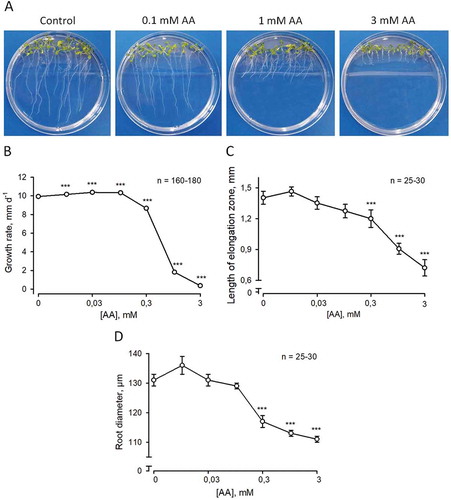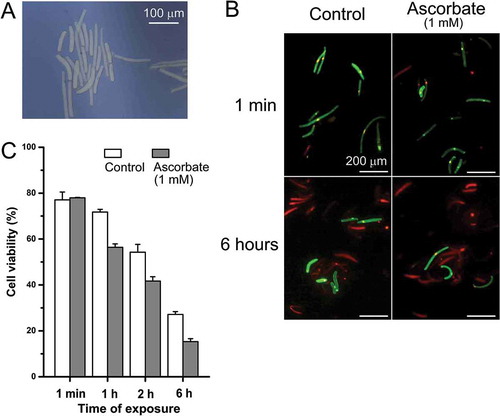Figures & data
Figure 1. Effect of ascorbate on Arabidopsis thaliana L. root growth. (A) Typical nine day-old plants cultivated vertically on Murashige and Skoog medium (original concentrations; Duchefa, #M0221) with ascorbate (concentrations are indicated in the figure). During the first four days, plants were growing without ascorbate, then medium below root tips was removed using razor blade and carefully replaced with the warm block of ascorbate-containing medium. This technique allows to avoid disturbance of plants. Root growth rate (B), length of root elongation zone (C) and root diameter (D) at different ascorbate levels in the medium. All parameters were measured at fifth day after exchange of media. Mean values (± SE) were plotted against the tested ascorbate concentrations (0.01 to 3 mM range). Plant cultivation techniques were as described by Makavitskaya et al.Citation5

Figure 2. Effect of exogenous L-ascorbic acid on viability of pea root border cells. (A) Typical root border cells of Pisum sativum L. (bright field). (B) Epi-fluorescent images (laser scanning confocal microscopy) of propidium iodide (PI; dead cells) and fluorescein diacetate (FDA; viable cells) staining. (C) Mean numbers (± SE) of viable cells (four independent trials) at different times of treatment by ascorbate. Seeds of pea were germinated under the mist culture as described elsewhere.Citation22–Citation24 Root border cells were harvested and purified as described previously.Citation22–Citation24 Pellets with root border cells were resuspended in a solution containing 0.3 mM CaCl2, 0.3 mM KCl, pH 6.0 (2 mM Mes), and then were treated with 1 mM L-ascorbic acid. At 1 min, 1 h, 2 h and 6 h, 90 μL of solution containing root border cells was mixed with 10 μL of FDA/1 μL PI solution (FDA from Fluka; PI from Sigma), and cell viability was determined as described elsewhere.Citation20

